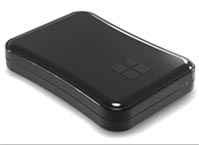My PC shrunk the hard drive: IT measurements can be confusing
 Frankfurt - The packaging says 500 gigabytes of storage, yet when that new hard drive is plugged into a computer it only shows up as having 465 gigabytes available.
Frankfurt - The packaging says 500 gigabytes of storage, yet when that new hard drive is plugged into a computer it only shows up as having 465 gigabytes available.
"Where's the rest of the space," bewildered buyers might ask. The answer is both simple and complicated: The difference is based on different calculation methods employed by manufacturers of storage media and operating system developers.
The bigger the storage, the more the difference becomes obvious - as much as ten per cent for a one terabyte hard drive. And to make matters worse, another small portion of the hard drive is lost when the device is formatted.
Many consumers presume that 1,000 bytes is a kilobyte, and that 1,000 kilobytes are a megabyte. After all, 1,000 metres make one kilometre, and 1,000 grams make one kilogram. Things are calculated differently in the world of IT, says Gerhard Henninger, an expert in multimedia standards at the German Commission for Electrical, Electronic, & Information Technologies (DKE) in Frankfurt.
"Computers work on a base two, not a base ten system. Properly speaking, that means that a kilobyte is not 1,000, but rather 1,024 bytes."
Just as engine makers typically round up displacement sizes, many producers of storage media - hard drives, flash drives, DVDs, Blu-Ray discs, and so on - make their products out to be bigger than they really are. They do so by listing the size as a factor of ten instead of a factor of two. That means making 1000 bytes into a kilobyte.
Yet nothing they say will convince an actual computer that 1024 bytes are a kilobyte. The operating system nevertheless requires more kilobytes to produce that gigabyte or terabyte figure quoted by the manufacturer.
Because the difference between 1000 and 1024 bytes is only 2.4 per cent, the difference is not that noticeable at the kilobyte level. Yet at the megabyte level the difference has already climbed to 4.9 per cent, and there's 7.4 per cent difference between the two calculation methods when sizing up a gigabyte.
Once you climb to the terabyte level, the storage maker's claims and actual space found by the operating system can be as much as ten per cent apart. "There is no plausible technical reason to state the size in anything but the technically correct size. Perhaps the manufacturers do it for simplicity's sake," Henniger says.
To avoid confusion, the Geneva-based International Electric Commission (IEC) proposed new descriptions all the way back in 1996. They called for storage media size to continue as accustomed when quoted in factors of ten, using names like kilobyte (KB), megabyte (MB), gigabyte (GB) and terabyte (TB). When that same size was to be calculated on a power of two, a "bi" was to be used for the second syllable, such as Kibibyte (KiB), Mebibyte (MiB), Gibibyte (GiB), Tebibyte (TiB) and so on.
Yet as frequently happens in the world of standards, the labels never caught the public's fancy and are not widely used, says Hans Harcken, an expert in magnetic storage systems at the Physikalisch-Technischen Bundesanstalt in Braunschweig.
Henniger sees legislation to end the unit confusion as unnecessary: "We have enough standards already."
Once you step back and think about the sizes and prices for storage media on the modern market, the difference is really not enough to get anyone worked up anymore, says Benjamin Benz from Hanover-based c't magazine.
"By the time you've filled up a terabyte hard drive, currently available for around 75 dollars, and the difference between 900 gigabytes and 1.02 terabytes becomes of significance, there's already by a newer cheaper one available," he says.
Benz recommends that consumers don't get worked up about the difference.
"Nobody who moves into a twelve room apartment is going to complain because the corridor is a half square metre less than advertised," he says. (dpa)